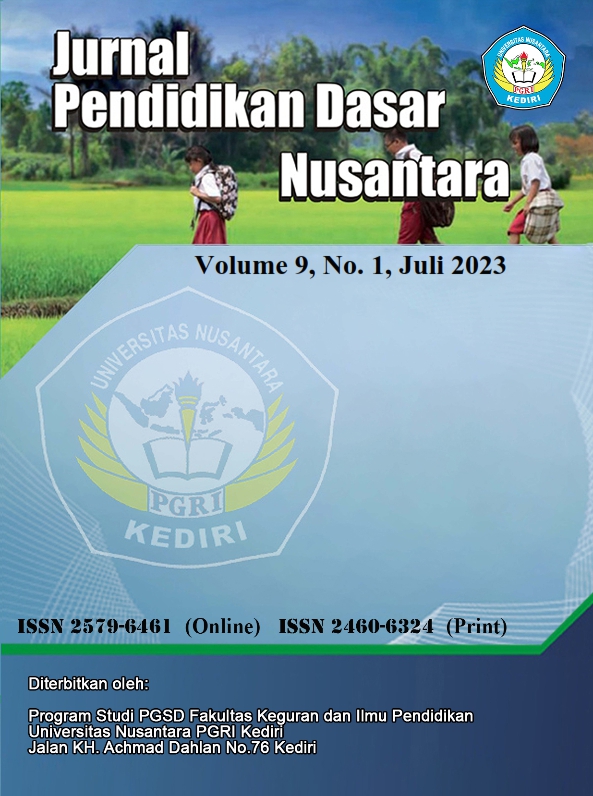The use of pasung media to improve collaboration and learning outcomes food chains class V SDN Mojorejo 1 Batu
DOI:
https://doi.org/10.29407/jpdn.v9i1.20147Keywords:
Pasung Media, Collaboration, Learning OutcomesAbstract
This Classroom Action Research aimed to find out the application of PASUNG media (connecting boards) to improve collaboration and learning outcomes for fifth-grade students at SDN Mojorejo 1 Batu City. The research method used was the classroom action research method. The subjects of this study were fifth-grade students at SDN Mojorejo 1 Batu City. Data on collaboration and learning outcomes were obtained from evaluation test results and student group activities through collaboration observation sheets. Based on the data obtained, learning using PASUNG media (connecting boards) can improve collaboration and student learning outcomes which can be seen from the results of student products in the form of miniature food chains. The results of student collaboration from Cycle I increased from 75% to 81% in Cycle II. Meanwhile, the average learning outcomes data of students in Cycle I was 73%, which increased to 85% in Cycle II. Based on the learning activities using PASUNG (Papan Sambung) media and creating a mini food chain project by the students, it can be concluded that the collaboration and learning outcomes of the students improved.
Downloads
References
Arsyad, A. (2019). Media Pembelajaran (21st ed.). PT RajaGrafindo Persada.
Astuti, D. Puji. , A. M. , D. B. (2020). Analisis Persiapan Guru Dalam Pelaksanaan Pembelajaran Matematika Di Kelas IV SD Negeri Jambu 01. Jurnal Wahana Pendidikan, 185–192.
Herlina, L. (2019). Upaya Meningkatkan Keterampilan Abad 21 Dengan Model Inquiry Levels Dalam Pembelajaran IPA. Bioed: Jurnal Pendidikan Biologi, 9–17.
Jalmo, T., Fitriyani, D., Yolida Pendidikan Biologi, B., Lampung, U., & Soemantri Brodjonegoro No, J. (2019). Penggunaan Problem Based Learning untuk Meningkatkan Keterampilan Kolaborasi Dan Berpikir Tingkat Tinggi. In Jurnal Bioterdidik (Vol. 7, Issue 3).
Lestari, N. (2019). Penerapan Model Pembelajaran Berbasis Proyek Untuk Meningkatkan Aktivitas Dan Hasil Belajar Siswa Kelas V SD Ar-Rahman Misriadi Desa Stabat Lama Langkat. Jurnal Pendidikan Dan Pembelajaran Terpadu (JPPT), 1(1), 13–23.
Mahmud, P. T. (2008). Penelitian Tindakan Kelas Teori dan Praktik.
Mu’alimin. (2014). Penelitian Tindakan Kelas Teori dan Praktik (Mu’alimin, Ed.).
Mujaiyanah, S. (2020). Mengukur Hasil Belajar Ekonomi Menggunakan Media Asesmen Word Search Puzzle Di Platform Android. Edunomic Jurnal Pendidikan Ekonomi, 8(2), 107–119. https://doi.org/10.33603/ejpe.v8i2.3669
Pratiwi, I. A. (2015). Pengembangan Model Kolaborasi JIGSAW Role Playing Sebagai Upaya Peningkatan Kemampuan Bekerjasama Siswa Kelas V SD Pada Pelajaran IPS. Jurnal Konseling GUSJIGANG, 1(2).
Sappe, Irwan. , Ernawati. , I. (2018). Hubungan Motivasi Belajar Terhadap Hasil Belajar IPA Siswa Kelas V SDN 231 INPRES Kapunrengan Kecamatan Mangarabombang Kabupaten Takalar. (JKPD) Jurnal Kajian Pendidikan Dasar, 3, 530–539.
Septikasari, R., & Rendy N. F. (2018). Keterampilan 4C Abad 21 Dalam Pembelajaran Pendidikan Dasar. Jurnal Tarbiyah Al-Awlad, VIII, 112–122.
Ulhusna, Mishbah. , S. D. Putri. , & Z. (2020). Permainan Ludo untuk Meningkatkan Keterampilan Kolaborasi Siswa dalam Pembelajaran Matematika. International Journal of Elementary Education, 4, 130–137.
Widiana, W., Rendra, N. T., & Wulantari, N. W. (2019). Media Pembelajaran Puzzle Untuk Meningkatkan Hasil Belajar Siswa Kelas IV Pada Kompetensi Pengetahuan IPA. Indonesian Journal Of Educational Research and Review, 2(3), 354–362.
MH, Z., & Wulandari, S. (2021). Analisis Penggunaan Media Papan Planel untuk Meningkatkan Minat Belajar Pada Materi Rantai Makanan di Sekolah Dasar. Jurnal Pendidikan Guru Pendidikan Anak Usia Dini, 3, 26–34.
Downloads
Published
Issue
Section
License
Authors who publish with this journal agree to the following terms:
- Copyright on any article is retained by the author(s).
- The author grants the journal, the right of first publication with the work simultaneously licensed under a Creative Commons Attribution License that allows others to share the work with an acknowledgment of the work’s authorship and initial publication in this journal.
- Authors are able to enter into separate, additional contractual arrangements for the non-exclusive distribution of the journal’s published version of the work (e.g., post it to an institutional repository or publish it in a book), with an acknowledgment of its initial publication in this journal.
- Authors are permitted and encouraged to post their work online (e.g., in institutional repositories or on their website) prior to and during the submission process, as it can lead to productive exchanges, as well as earlier and greater citation of published work.
- The article and any associated published material is distributed under the Creative Commons Attribution-ShareAlike 4.0 International License
































